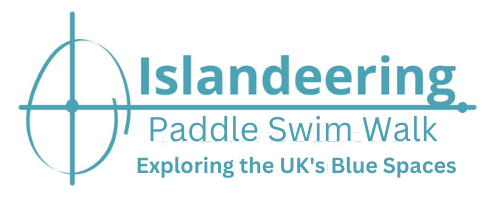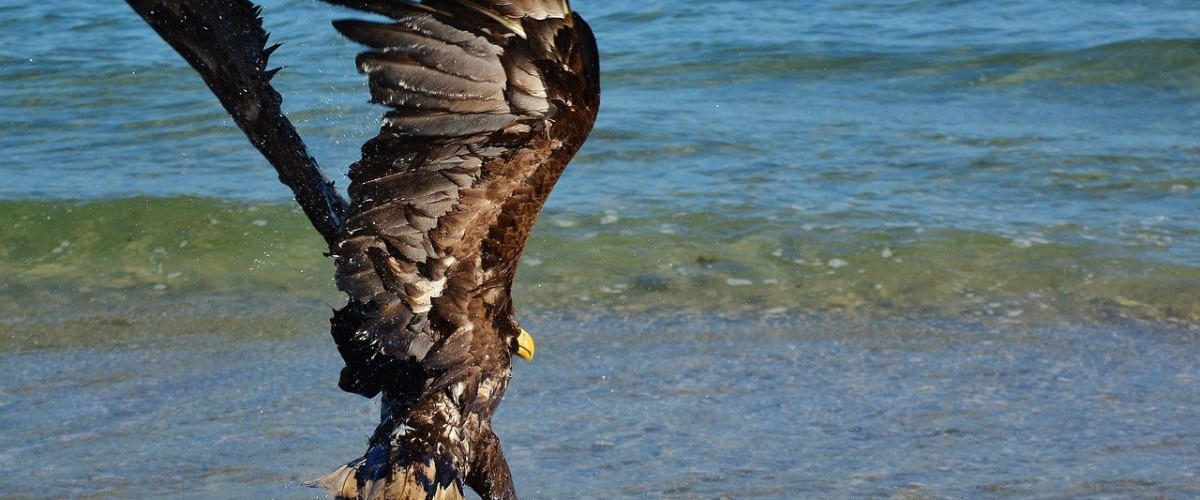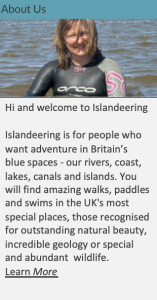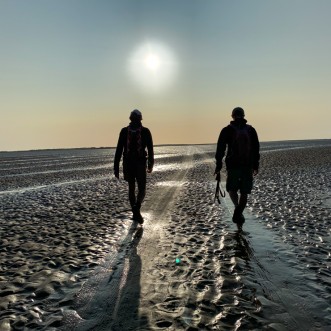BBC Wild Isles has already started to showcase the incredible wildlife and habitats we have right on our doorstep. Here we share how you can visit the island filming locations and spot the incredible wildlife, also how to support the organisations that are looking after these very special blue spaces.
SCOTLAND
Shetland Isles
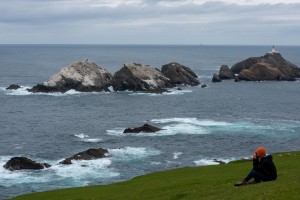
Some of the most memorable footage on BBC Wild Isles episode one was of orcas and seals on the Shetland Islands. Much of the action was filmed in the waters around the rocky island of Mucka Flugga off the north coast of Unst and often referred to the northernmost point of the British Isles. Muckle Flugga is not easy to reach but it can be easily viewed from the cliffs of the Hermaness National Nature Reserve – a top spot for seeing puffins up close, and vast colonies of fulmars, kittiwakes and gannets whilst great skuas dive overhead. The whole of the Hermaness National Nature Reserve is a very special blue space, much of which can be experienced on our favourite 13km walk through the reserve to see Muckle Flugga and the spectacular cliffs and wildlife around that was first printed in The Times, Walk of The Week for Scotland. Any visit to Shetland starts on its Mainland and, as an archipelago of 300 or so smaller islands with 16 of those inhabited, there is plenty to explore. Orcas can be found in the waters around all of the islands. To increase your chances of spotting them visit the Shetland Wildlife Facebook page which regularly posts their current location, along with that of numerous whale species, dolphin, porpoise and more at Shetland Orca Sightings Facebook
Need to know
The best way to get to Shetland is either by ferry or flying from all major cities in Scotland. There is a daily ferry service between Aberdeen and Lerwick, operated by Northlink Ferries which takes 12 hours on an overnight sailing. Flights arrive in Sumburgh airport, south of Lerwick and are operated by Logan Air.
The best way to get to Hermaness National Nature Reserve from the Shetland mainland there are two ferry crossings to reach Unst via Yell. Hermaness is then eight miles drive from Baltasound; take B9086 to car park.
Getting around Shetland is via inter-island ferries to all inhabited islands and inter-island flights from Tingwall airport, north of lerwick to Foula, Fair isle and Papa Stour
Whale watching in Shetland is possible from the coast, we’ve spotted them off Sumburgh Head. Whales and orca can also be spotted from the decks of the inter-island ferries. For more dedicated whale watching you can join a wildlife spotting trip such as Sea Adventures
More information in Scotland Island Bagging book from Walk Highlands
Support the following organisations who look after these wild isles:
Whale and Dolphin Conservation
Hebridean Whale and Dolphin Trust
Shetland Community Wildlife Group
Bass Rock, Firth of Forth
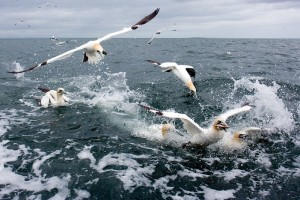
In the Firth of Forth the huge bulk of Bass Rock sits nearly 5km offshore from the lovely town of North Berwick, on the east coast of Scotland. It is home to the world’s largest gannet colony, along with a 19th-century lighthouse and a ruined castle. During an average year Bass Rock is home to 150,000 birds, which is around 10% of the world’s gannet population and the tiny island is of global significance. As such this special blue space is designated as a Site of Special Scientific Interest and is part of a Special Protection Area. Watching the birds swirl and dive into the sea around the island is an experience you’ll never forget. Image by Keith Marshall is licensed under CC BY-NC-SA 2.0.
Need to know
The best way to get to Bass Rock is on a boat trip from the Scottish Seabird Centre in North Berwick which run from march to early October, the best time to see the gannets. Landing trips cost £140 pp/16+ only; or 1-hour boat trips around the island cost £27 per adult/£12 per children – book online. With binoculars you can get a good view of Bass Rock from the hilltop of Berwick Law above North Berwick. The Scottish Seabird Centre in North Berwick which has live-action camera feeds directly from the rock.
More information in Scotland Island Bagging book from Walk Highlands
Support the following organisations who look after these wild isles:
Islay, Inner Hebrides
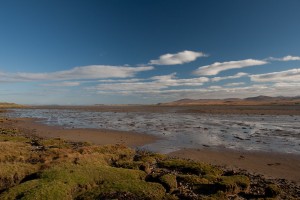
Known as the ‘Queen of the Hebrides’ Islay is a haven for bird and nature watchers – as well as whisky lovers drawn to the island’s world-class whisky distilleries including Lagavulin and Lophraig. BBC’s Wild Isles filmed the white-tailed sea eagles hunting amongst the thousands of geese (Greenland Barnacle, Greenland White-Fronted and Light-bellied Brent) that overwinter at RSPB’s Loch Gruinart which is a special blue space designated as a RAMSAR site. There are also other rare species to see too, such as the corncrake and chough. Image by Odd Wellies is licensed under CC BY 2.0.
Need to know
The best way to get to Islay is via CalMac vehicle ferries from Oban or Kennacraig on the Kintyre Peninsula which sail 2-3 times a day, landing either in Port Ellen in the south or Port Askaig adjacent to Jura.
The best way to get around Islay is by public bus, your own car or local taxi and tours, more info here https://www.islayinfo.com/get-here/getting-around
More information in Scotland Island Bagging book from Walk Highlands
Support the following organisations who look after these wild isles:
ENGLAND
Farne Islands, Northumberland
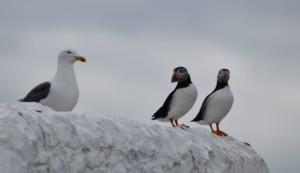
A true wildlife spectacle, these rugged islands are home to around forty-three thousand pairs of puffins and are one of the top grey seal pupping sites in England with more than two thousand pups born every autumn. The fifteen to twenty islands (the exact number depends on the level of the tide) in this archipelago are scattered between two and seven kilometres from the mainland. This is a special blue space designation as a National Nature Reserve, a Site of Special Scientific Interest, is part of the Northumberland Coast Area of Outstanding Natural Beauty and is a Special Conservation Area for the grey seals which breed and rest there. There are three main islands. Inner Farne is a popular landing spot for tour boats to watch puffins and Arctic terns and to visit the medieval chapel of St Cuthbert. Staple Island offers unrivalled close-up views of the over ten thousand pairs of puffins that breed on the cliff faces of The Pinnacles. Boat trips land here during the breeding season only (1 May until 31 July). Longstone is also well worth a visit to see the lighthouse that was once the home to Victorian heroine, Grace Darling, whose father was the light’s keeper. Find out more in our book Island Bagging England and Wales.
Need to know
The best way to get to the Farne Islands is via a landing boat tour from nearby Seahouses. Billy Shiels Boats lands on both Inner Farne and Staple Islands, costs £30/adult, £23/child. There is a basic loo on Inner Farne only and on the boat itself. The only boat allowed to land on Longstone is Golden Gate Farne Island Boat Trips, cost £25/trip.
Support the following organisations who look after these wild isles:
Old Harry Rocks, Dorset
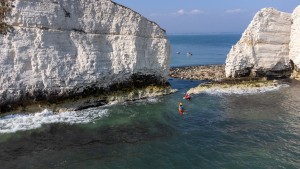
Old Harry Rocks are three iconic chalk formations, including a stack and a stump, located at Handfast Point on the Isle of Purbeck at the easternmost point of the Jurassic Coast, a UNESCO World Heritage Site. The rocks, owned by the National Trust, can be viewed from the South West Coast Path at The Foreland. Old Harry rocks used to be part of a long stretch of chalk between Purbeck and the Isle of Wight before large parts of this seam were eroded away. They are an excellent destination for sea kayakers, where the small caves and huge stacks can be experienced up close. Old Harry Rocks is a very special blue space, it sits in a UNESCO World Heritage Site (The Jurassic Coast), a Marine Conservation Zone, Marine Protected Area, Special Area of Conservation, and a Site of Special Scientific Interest.
Find out more in our book Island Bagging England and Wales.
Need to know
The best way to get to Old Harry Rocks is from South Beach Car Park at Studland Bay followed by a 1.6km walk along fields and grassland to reach the clifftop, with great views over Studland Bay along the walk. Old Harry Rocks can be viewed from Ballard Down on the South West Coast Path. It is possible to swim or paddle to Old Harry Rocks from Studland Beach for those competent at understanding the tides here. Check out our favourite 16 km walk around Old Harry’s Rocks.
Support the following organisations who look after these wild isles:
WALES
Skomer Island, Pembrokeshire
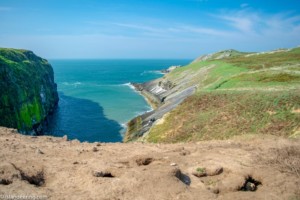
Only one kilometre off the coast of Pembrokeshire this is an island of exposed headlands, dramatic sea stacks, and sheltered bays that is famed for its extraordinary wildlife. It is the seasonal home to half the world’s population of Manx shearwaters and the largest colony of Atlantic puffin in southern Britain. The highest density of birds can be seen at The Wick, a spectacular, deep inlet along the island’s south coast with dramatic cliff faces where razorbills build single nests in crevices while guillemots construct seabird cities that echo with their kazoo-like calls. Inland from the cliffs thousands of puffins nest in the grassy banks between April and July before leaving to overwinter in the Atlantic Ocean. Skomer is also home to the unique Skomer vole, three species of stick insect, glow-worms and slow-worms with plenty of offshore life that includes dolphins and porpoise, which are often spotted on the boat trip across Jack Sound, along with good views of Midland Isle. Skomer is a special blue space, and is designated as a Marine Conservation Zone and a National Nature Reserve. Overnight self-catering accommodation in the island’s Old Farm is very popular and guests are offered a nightly bird log and talks from conservation experts.
Find out more in our book Island Bagging England and Wales.
Need to know
The best way to get to Skomer island – boats sail to Skomer from Martin’s Haven every day (weather dependent) except Monday from April to September. Book online.
Best way to get around Skomer Island – check out our walk around Skomer Island to visit all the wildlife highlights
Support the following organisations who look after these wild isles:
The Wildlife Trust of South and West Wales
You might also be interested in:
What we can do to look after our seas
